Office Wastes
While much has been said and written about Lean and the 7-Wastes within a manufacturing environment, it is in the office of professional service functions where we often see huge amounts of waste, particularly within the accounting, legal, design and consulting engineering sectors. Below are some of the typical ‘Office Wastes’ that we encounter.
- Sorting and searching – This applies in all environments, even at home. How much time do you waste looking for files, or information, or tools or items? Although we like to talk about the ‘paperless office’, we know that this is far from reality. Many organisations generate “paper”, for e.g. the medical and legal professions, or any regulatory bodies or departments. How do you track these documents and know, instantly, where anything is? If you manufacture anything, where and how do you track the correct revision numbers?
- Duplication – In many cases, duplication can be avoided by IT systems that integrate better. How often have you seen it where you go to an organisation and you are required to fill in your personal details more than once? Inappropriate Measurement – We all know that measures drive behavior. What is being measured? Are the measurements driving the business in the right direction and are they linked to the business objectives?
- Underload and Overload – Many organisations experience underload and overload at certain times, where this could be daily, monthly, annually or seasonally. This creates staffing issues and often results in unhappy customers. Think about the process when you check-out of a hotel. You go down to reception in the morning and typically there is a queue of people trying to check-out. How do you overcome this daily overload? Some hotels have a system whereby they ask you, when you check-in, whether they can put your bill under your door early on the morning that you are due to check-out. This permits you to check the bill in your room, and if it is correct, you simply sign it and leave it at reception on your way out. Other hotels use their internal intranet which you can access via the TV in the room.
- Inappropriate Priorities – Focusing on the wrong things. Stephen Covey talks about his 4-square matrix…..are you doing those tasks that are important & urgent, or those that are not important or not urgent. Interference – emails, people “visiting” each other, and social media. Perhaps the most common office waste is when “everybody” is copied in on emails. How much time do employees spend on social media at work?
- Inappropriate Frequency and Presence – Are you holding daily meetings, like a sales, design or production meeting, because you always hold them, or because they are really necessary? So often we see companies holding meetings where little, and in many cases, nothing is achieved! How long are these meetings? Who attends these meetings and do they have to attend? Could you hold the meetings less often? Could the meetings be done via Skype or video conferencing? Can the meetings be changed from a sit-down conference room meeting, to a stand-up meeting to make them shorter and more relevant?
- Mistakes, errors, Lack of Knowledge – People make mistakes. After the WWII, Deming was instrumental in revitalizing Japanese manufacturing and he talked about his 94/6 Rule, i.e. 94% of all mistakes and errors are caused by the system or process not being correct and only 6% by the people.
- Waiting – If any document, or person, or product stands still, it cannot (by definition) be adding value. Waiting for someone or information from a previous stage, or signoff authorization etc, is all non-value adding.
- Over-design or doing something that the customer doesn’t want – This is particularly relevant for consulting engineering-type organisations, where we have come across situations where the designers are producing drawings that the customer did not actually ask for….they produce the drawings because it is a nice technical challenge!
Office wastes are not eliminated by imposing additional rules, but by assisting, mentoring, and questioning work processes, with the critical question being…”From the customer’s perspective, is this task or process adding value?”















